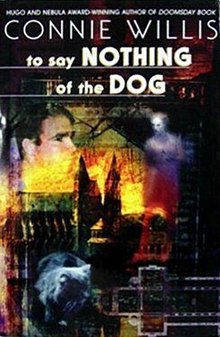To Say Nothing of the Dog

Cover of first edition (hardcover)
|
|
| Author | Connie Willis |
|---|---|
| Country | United States |
| Language | English |
| Genre |
Science fiction Comedy |
| Publisher | Bantam Spectra |
|
Publication date
|
1997 |
| Media type | Print (Paperback) |
| Pages | 434 pp |
| Awards | Locus Award for Best Science Fiction Novel (1999) |
| ISBN | |
| OCLC | 36954540 |
| 813/.54 21 | |
| LC Class | PS3573.I45652 T6 1997 |
To Say Nothing of the Dog: or, How We Found the Bishop's Bird Stump at Last is a 1997 comic science fiction novel by Connie Willis. It takes place in the same universe of time-traveling historians she explored in her story Fire Watch and novels Doomsday Book (1992) and Blackout/All Clear (2010).
To Say Nothing of the Dog won both the Hugo and Locus Awards in 1999, and was nominated for the Nebula Award in 1998.
The book's title is inspired by the subtitle of an 1889 classic work, as explained by the author in the dedication: "To Robert A. Heinlein, Who, in Have Space Suit—Will Travel, first introduced me to Jerome K. Jerome's Three Men in a Boat, To Say Nothing of the Dog."
The story begins in 2057 at Oxford University. A machine which makes time travel possible has been developed, but time travel itself is used primarily as a tool for historical research. Although millions were spent to develop time travel as a commercial venture, it turned out to have no profit potential. The natural laws of the "time continuum" prevent anything of significance from being brought from the past to the future, and also act to keep time travellers away from historically critical events, such as the Battle of Waterloo. Any attempt to break these laws results in the time machine preventing the desired goal of travel: the time traveller is sent to the right time but to a distant place (30 miles from the Coventry Cathedral, or Mexico, to give two examples in the novel), or to the right place but a time distant enough to keep the traveller from interfering in a way that might create a paradox (the narrator reaches the Cathedral but in the year 1395). In extreme situations, the continuum can correct paradoxes by changing the course of events in minor ways to keep the eventual outcome the same.
...
Wikipedia
